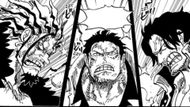Fans of One Piece are wishing for a canon movie to be made for the big screens, as recently the anime film industry has changed for the better. With movies like Chainsaw Man: The Reze movie to Demon Slayer: Infinity Castle, all of them are becoming massive blockbuster successes and have become globally popular. We also have a new Jujutsu Kaisen movie, which is causing this fandom to urge Toei Animation to also work on a One Piece movie.
Moreover, many believe that the God Valley Incident arc is the perfect story to be released in theaters as it is relatively shorter and will not disrupt the flow of the show. For years, One Piece fans have been fascinated by God Valley, a place tied to legends like Gol D. Roger, Monkey D. Garp, Rocks D. Xebec, and the birth of the Yonko era. And with its blend of action, tragedy, and mythic weight, it has movie material written all over it.
The cinematic potential of God Valley

If we think about it, the God Valley Incident is where we saw legends in their prime. We have Garp and Rogers working together, and no one can guess who did this unlikely duo accept to be teamed up. Meanwhile Rocks Pirates are in their young version, who have experienced these events firsthand and lived to tell the tale.
Moreover, this plotline has no member of the Straw Hat, so watching other characters get spotlight might be a good change in pace. That’s exactly what makes it perfect for a movie. The scope is self-contained, and it wouldn’t need to drag across dozens of weekly episodes. Toei could give it the visual grandeur and pacing that television sometimes limits, with cinematic lighting, tighter storytelling, and no filler.
Lessons from Demon Slayer and Jujutsu Kaisen

Critics have often pointed out that One Piece doesn’t need to chase the generic shonen anime formula. After all, One Piece already dominates the global anime market without theatrical tie-ins. But it’s not about imitation, it’s about innovation. Demon Slayer’s Infinity Castle and Chainsaw Man Reze movie proved that canonical movies can heighten emotional stakes and give a series breathing room to deliver higher-quality animation and direction. Imagine Toei dedicating a full two-hour runtime to the God Valley event, without worrying about weekly production constraints.
There are a few fans who feel like Toei Animation would not want to produce a movie where Luffy is not the main part of it, as he is the heart of the franchise. But that is the beauty of the God Valley incident; the movie could be seen as a prequel for the current timeline. If done right, the Straw Hats could still make an appearance or maybe get some extra scene in post-credits that would tease towards the events taking place in the Elbaf arc.
The emotional and historical payoff

God Valley is not just another battle. It’s the story that birthed legends and reshaped the world’s power balance. We’d see Roger before the Pirate King title, Garp before his hero status, and Rocks at the height of his chaos. It’s tragedy, ideology, and ambition colliding, all themes One Piece excels at portraying.
Moreover, a God Valley movie would allow Eiichiro Oda to oversee the adaptation with tighter creative control, ensuring the event feels cohesive within the canon. It could even serve as a bridge, tying the Rocks era’s mysteries to the ongoing Elbaf arc and teasing the endgame of the series.
If titles like Demon Slayer, Jujutsu Kaisen, and Chainsaw Man proved canon arcs can work on the big screen, One Piece could prove they can elevate them. In the end, a God Valley incident film would celebrate everything that makes One Piece special: its history, its mythos, and its sense of adventure that transcends time.
